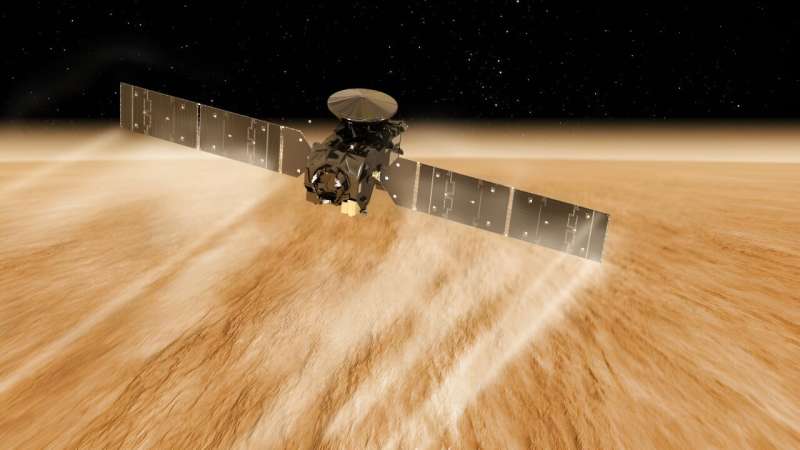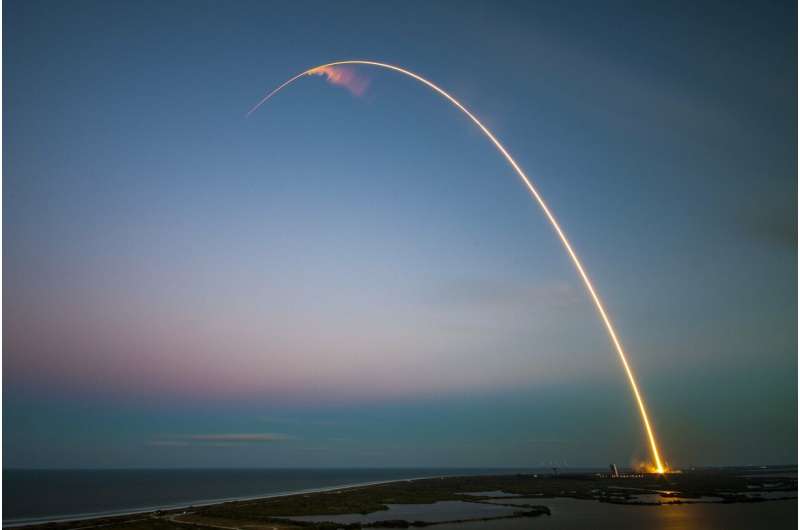
Copernical Team
Ovzon and SSC close to sealing satellite communication contract worth $10M
 Ovzon AB, a leading provider of satellite communication services, is currently in the final stages of negotiations with the Swedish Space Corporation (SSC) for a significant order. This potential deal, estimated at approximately 10 million USD, involves the provision of SATCOM-as-a-Service, including Ovzon's innovative mobile satellite terminals, with a projected delivery timeline in 2024.
Ovzon AB, a leading provider of satellite communication services, is currently in the final stages of negotiations with the Swedish Space Corporation (SSC) for a significant order. This potential deal, estimated at approximately 10 million USD, involves the provision of SATCOM-as-a-Service, including Ovzon's innovative mobile satellite terminals, with a projected delivery timeline in 2024. NASA's Fermi Mission Nets 300 Gamma-Ray Pulsars ... and Counting
 A new catalog produced by a French-led international team of astronomers shows that NASA's Fermi Gamma-ray Space Telescope has discovered 294 gamma-ray-emitting pulsars, while another 34 suspects await confirmation. This is 27 times the number known before the mission launched in 2008.
"Pulsars touch on a wide range of astrophysics research, from cosmic rays and stellar evolution to the se
A new catalog produced by a French-led international team of astronomers shows that NASA's Fermi Gamma-ray Space Telescope has discovered 294 gamma-ray-emitting pulsars, while another 34 suspects await confirmation. This is 27 times the number known before the mission launched in 2008.
"Pulsars touch on a wide range of astrophysics research, from cosmic rays and stellar evolution to the se NASA Orbiter snaps stunning views of Mars horizon
 Astronauts often react with awe when they see the curvature of the Earth below the International Space Station. Now Mars scientists are getting a taste of what that's like, thanks to NASA's 2001 Mars Odyssey orbiter, which completed its 22nd year at the Red Planet last month.
The spacecraft captured a series of panoramic images that showcases the curving Martian landscape below gauzy layer
Astronauts often react with awe when they see the curvature of the Earth below the International Space Station. Now Mars scientists are getting a taste of what that's like, thanks to NASA's 2001 Mars Odyssey orbiter, which completed its 22nd year at the Red Planet last month.
The spacecraft captured a series of panoramic images that showcases the curving Martian landscape below gauzy layer Boosting rocket reliability at the material level
 The success of the SpaceX Falcon 9 reusable launch vehicle has been one of the most remarkable technological achievements of the last decade. Powered by SpaceX's Merlin engine, the Falcon 9 booster can be reused over 10 times, with minimal maintenance between flights.
Now there is a new generation of reusable rocket engines and vehicles that promise much larger payloads and greater reuse.
The success of the SpaceX Falcon 9 reusable launch vehicle has been one of the most remarkable technological achievements of the last decade. Powered by SpaceX's Merlin engine, the Falcon 9 booster can be reused over 10 times, with minimal maintenance between flights.
Now there is a new generation of reusable rocket engines and vehicles that promise much larger payloads and greater reuse. Finnish team of researchers found out the composition of asteroid Phaethon
 The asteroid that causes the Geminid shooting star swarm has also puzzled researchers with its comet-like tail. The infrared spectrum of rare meteorites helped to determine the composition of the asteroid. Asteroid Phaethon, which is five kilometers in diameter, has been puzzling researchers for a long time. A comet-like tail is visible for a few days when the asteroid passes closest to the Sun
The asteroid that causes the Geminid shooting star swarm has also puzzled researchers with its comet-like tail. The infrared spectrum of rare meteorites helped to determine the composition of the asteroid. Asteroid Phaethon, which is five kilometers in diameter, has been puzzling researchers for a long time. A comet-like tail is visible for a few days when the asteroid passes closest to the Sun Solar activity likely to peak next year, new study suggests
 Researchers at the Center of Excellence in Space Sciences India at IISER Kolkata have discovered a new relationship between the Sun's magnetic field and its sunspot cycle, that can help predict when the peak in solar activity will occur. Their work indicates that the maximum intensity of solar cycle 25, the ongoing sunspot cycle, is imminent and likely to occur within a year. The new research ap
Researchers at the Center of Excellence in Space Sciences India at IISER Kolkata have discovered a new relationship between the Sun's magnetic field and its sunspot cycle, that can help predict when the peak in solar activity will occur. Their work indicates that the maximum intensity of solar cycle 25, the ongoing sunspot cycle, is imminent and likely to occur within a year. The new research ap Aerocapture is a 'free lunch' in space exploration

When spacecraft return to Earth, they don't need to shed all their velocity by firing retro-rockets. Instead, they use the atmosphere as a brake to slow down for a soft landing. Every planet in the solar system except Mercury has enough of an atmosphere to allow aerobraking maneuvers, and could allow high-speed exploration missions. A new paper looks at the different worlds and how a spacecraft must fly to take advantage of this "free lunch" to slow down at the destination.
Aerocapture is an orbital transfer maneuver in which a spacecraft makes a single pass through a planetary atmosphere to decelerate and achieve orbit insertion. On the other hand, aerobraking uses a propulsive burn plus repeated dips into the atmosphere—i.e., atmospheric drag—to gradually slow the spacecraft and reduce the size of the orbit to achieve orbit insertion.
The new paper posted to the arXiv preprint server, by Athul Pradeepkumar Girija from the School of Aeronautics and Astronautics at Purdue University, notes that one of the significant risks associated with aerocapture is the uncertainty in the atmospheric density.
If warp drives are impossible, maybe faster-than-light communication is still on the table?

I'm sure many readers of Universe Today are, like me, fans of the science fiction genre. From the light sabers of "Star Wars" to the neuralyzer of "Men in Black," science fiction has crazy inventions aplenty and once science fiction writers dream it, scientists and engineers try and create it. Perhaps the holy grail of science fiction creations is the warp drive from "Star Trek" and it is fair to say that many have tried to work out if it is even possible to travel faster than the speed of light. To date, alas, to no avail but if the warp drive eludes us, what about faster-than-light communication.
Let's start with the warp drive. The concept is a drive that can propel a spacecraft at speeds in excess of the speed of light. According to the "Star Trek" writers, the speed was described in factors of warp speed where they are converted to multiples of the speed of light by multiplication with the cubic function of the warp factor itself. Got it. Don't worry, it's not crucial to this article.
SpaceX sends up Space Coast's 66th launch of the year

SpaceX chalked up another Starlink mission from Cape Canaveral Space Force Station to mark the Space Coast's 66th launch of the year.
A Falcon 9 with 23 of the company's Starlink internet satellites lifted off from Canaveral's Space Launch Complex 40 at 11:20 p.m. Monday.
The booster flew for the 17th time, the third time SpaceX has flown one of its boosters 17 times, although one has flown 18 missions. It landed safely on the droneship Just Read the Instructions downrange in the Atlantic.
This is the fourth month in a row the Space Coast has shoehorned in seven launches in a month, and the fifth time this year, although only the second time SpaceX has been responsible for all seven of those launches in one month.
SpaceX has flown 62 of the 66 Space Coast missions overall, with Relativity Space making its lone launch of its Terran 1 3D-printed rocket back in March, and United Launch Alliance managing one Delta IV Heavy and two Atlas V rocket launches since June.
SpaceX has also flown 25 times from California's Vandenberg Space Force Station, making this its 87th orbital flight this year, not counting the two failed attempts to launch its Starship and Super Heavy rocket from Texas.
Warming ocean causing rapid glacier retreat

With all eyes about to focus on the COP28 climate conference in Dubai, new scientific findings show, again, that the climate crisis is taking its toll on Antarctica – a continent, up to recently, thought better able to withstand the immediate effects of rising global temperatures.
Using satellite data, scientists have discovered that the ice shelf extending into the ocean from Cadman Glacier on the west Antarctic Peninsula collapsed, leaving the glacier exposed to unusually warm ocean water, which caused the glacier to accelerate and retreat rapidly.

